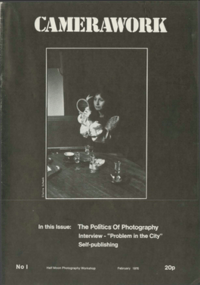Camerawork (magazine)
Camerawork (1976 - 1985) was a British bi-monthly photography magazine promoting humanist, socialist and activist photography.[1]
 | |
| Editor | Jo Spence |
|---|---|
| Editor | Terry Dennett |
| Frequency | bi-monthly |
| Format | A2>A4 folding broadsheet |
| Publisher | Half Moon Photography Workshop |
| Year founded | 1976 |
| Final issue Number | no. 32, summer 1985 |
| Country | United Kingdom |
| Language | English |
| ISSN | 0308-1672 |
| OCLC | 480398473 |
History
Half Moon Photography Workshop, a collective of photographers later known as Camerawork, initiated community photography education and publishing activities in the East End in the early 1970s,[2] and out of this grew the magazine Camerawork, established in 1976 by Jo Spence with the socialist historian of photography Terry Dennett[3].
They were joined on the cooperative editorial team for the first edition (February 1976), themed 'The Politics of Photography', by Tony Bock, Roger Eaton, Mike Goldwater, Janet Goldberg, Marilyn Noad, Tom Picton, George Solomonides, and Paul Trevor, with writings by Terry Dennett, Tom Picton, Jo Spence, and Paul Trevor and pictures by Nick Hedges, Ron McCormick, Larry Herman, Chris Searle, Exit, Helmut Newton, and Claire Schwob.[4] Subsequent editions were also themed, with often controversial topics.
Origins
Coming out of the 1960s protests and Marxism, documentary photography in the 1970s, Camerawork's humanist, leftist stance and preference for politically 'committed' or 'activist' photography was established from the first issue, in which the editorial read;
Photographers since Lewis Hine and Jacob Riis have shown the things in our society that need to be changed. People have done community work since the great charitable settlements were established in our big cities during the last century. Community photographers, however, want to give more than charity or expose social injustice. They believe that people can use photography to make their own demands and help to make them free.[5]
The magazine promoted several photographer collectives; the Hackney Flashers, Union Place and the Exit Group of Chris Steele-Perkins, Nicholas Battye and Paul Trevor.[6]
The magazine folded in 1985, with no. 32, summer 1985.[7]
Legacy
The Camerawork archive[8] is owned by the Photography and the Archive Research Centre (PARC) at the University of the Arts London (UAL) and makes all copies of Camerawork available to view online as well as resources covering Four Corners and Half Moon Photography Workshop (later Camerawork) for the period 1972 to 1987: oral histories, film and audio archive, and more than 3000 examples selected from exhibitions, posters, press releases and ephemera.
References
- Evans, Jessica (1997), The camerawork essays : context and meaning in photography, Rivers Oram Press ; New York : Published in the USA by New York University Press, ISBN 978-1-85489-081-8
- Jessica Starns (2013) The Camerawork Archive, Photography and Culture, 6:3, 341-348, DOI: 10.2752/175145213X13735390913368
- Watney, Simon (Spring 1986). "Jo Spence". History Workshop. Oxford University Press (21): 211.
- "Camerawork Magazine - Issue 01". www.fourcornersarchive.org. Retrieved 2019-08-03.
- “Editorial”. Camerawork 13 (March 1979) : 1
- Capet, Antoine (2009), The representation of working people in Britain and France : new perspectives, Newcastle-upon-Tyne Cambridge Scholars Publishing, ISBN 978-1-4438-1534-5
- Half Moon Photography Workshop. Publishing Project (1976), Camerawork, Half Moon Photography, ISSN 0308-1672
- "Four Corners Archive - About us". www.fourcornersarchive.org. Retrieved 2019-08-03.